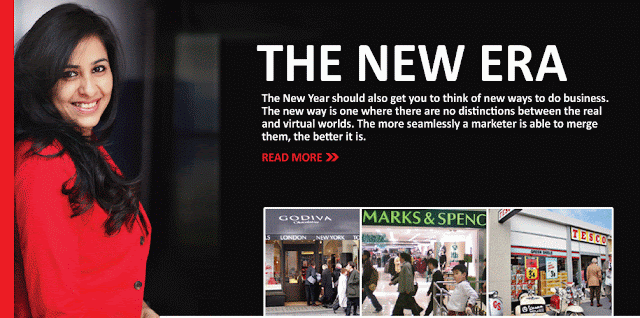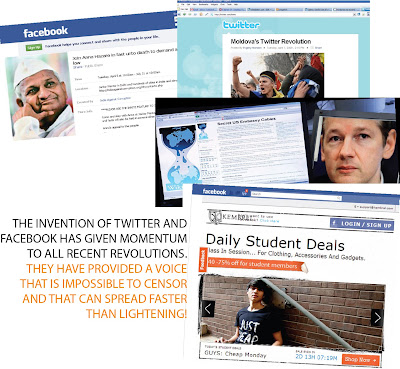THE NEW ERA
The New Year will, as always, bring with it a change. For marketers too it will be a year of looking at business, at consumers, at strategies, at investments, even at job profiles in a different manner.
IBM is in the business of computers. Well, so you thought, for it does much more now. This year, it is also in the business of selling what is known as ‘trend detection’ to marketers. The hottest trend in fashion, music, etc this year is predicted to be ‘the Steampunk movement’. Who predicted it? Yes, IBM! It developed a model using proprietary software that studied various conversations happening in various networking sites like Twitter, Facebook, Pinterest etc for years and also in the numerous blogs, and discovered that “Steampunk” was being mentioned more and more frequently and hence predicted that this was a trend to stay. It has been proved right as the popularity of this trend is increasing. Even the fashion label Prada launched its new fashion line with ‘Steampunk’ as the theme. What started as a literary subgenera in the 1980s is today a hot selling fashion trend. Now, IBM is offering its services to brands where it can help them predict and identify new trends with the help of its new software and be better prepared for the future. It is no more the traditional computer manufacturer.
Think about it, the job of a singer is to sing well; and if he is popular, he gets to endorse brands. Not anymore! Will.i.am, the lead singer of the band The Black Eyed Peas, just proved it wrong. Unlike other rock stars, his brand endorsements are different. When Coke wanted to sign him up as their brand ambassador, he convinced them instead to start a new division ‘Ekocycle’ (look carefully it’s actually Coke spelt backwards) and endorse that. He had deeply studied the company profile and found that this was an idea which would benefit both him and Coke, something no brand ambassador is expected to do. Rather, it’s the reverse as brands study the profile of the star to see if he fits well with the brand! This new division would promote ‘recycling’, with each product being labelled, stating clearly how many bottles were recycled while manufacturing the product. For example, a pair of headphones uses three bottles. The idea was a huge success, and today Coke and Will.i.am divide the profits equally from this division. Not just this, Coke probably for a very long time, will not change its brand ambassador either and many companies would be lining up at Will’s door to sign him up. Will has proved that it pays to not just be the traditional brand endorser, but to go a step beyond. Soon gone would be the days of many things traditional, one of them being shopping!
Definitions are changing, lines are blurring in the New Year. Let’s see how things will change even more everywhere.
THE DIFFERENCE BETWEEN TRADITIONAL INDUSTRY BOUNDARIES WILL BLUR...
Mobiles are blurring the differences between traditional industrial boundaries. A few years ago, Amazon was known as an eretailer while eBay was an online auction site, and Apple made personal computers. Today eBay, Apple, Amazon, and many more are all e-retailers and all are investing in ‘mobile technology ‘ very heavily as for each of them, the future business depends on this. Just focusing on the traditional channels of distribution, promotion will not work anymore. You need to integrate as many channels as possible and blur boundaries.
Home Depot, a brick and mortar outlet, sells home improvement goods, but now it also invests heavily in virtual technology to help increase sales. It now offers a ‘mobile wallet’ so that the customer can pay via PayPal at the cash counter. This has increased its turnover and customer satisfaction. eBay invested $5 billion in mobile technology. The God of all integrations and innovations – Apple – now allows customers to walk into their retail store, scan the bar code with their phone cameras, pay through iTunes and walk out. It’s the best omni-channel retailer in business today. If you want to succeed in the future, you too need to focus towards becoming an ‘omnichannel retailer’, or multi-channel retailer.
Godiva today does not just concentrate on making the best chocolates in the world but spends considerable time studying its consumers’ online history too and customize its campaigns almost immediately on the basis of customer reactions. For example in one case, they tested three different price points for free shipping qualifications. A, B and C, with ‘A’ as the highest price and ‘C’ as the lowest price. Everyone knew that the offer with the lowest price (i.e. offer ‘C’) would be the most attractive to consumers to avail of the ‘free shipping’ facility. Surprisingly, data analysis proved that ‘B’ was the most popular deal with consumers and made the company change its strategy immediately. Similarly, according to its VP Mahender Nathan, when they put more photographs of the same product showing alternate views, sales increased. An invitation to enter their e-mail address and get special offers was a move the company thought would turn potential consumers away, but to its surprise it increased the e-mail capture by 1,076% – that’s huge! Godiva now invests heavily in technology to help understand consumers better and serve them across various channels, be they real or virtual. A good web display is as important as a good instore shelf display.
THE REAL & VIRTUAL WORLD WILL BLUR…
The New Year should also get you to think of new ways to do business. The new way is one where there are no distinctions between the real and virtual worlds. The more seamlessly a marketer is able to merge them, the better it is. Take the case of the multi-brand retailer Tesco. Its department ‘Tesco Groceries’ now has a fancy website from where consumers can order their groceries, decide the time they want the delivery, decide the place of delivery, which could be home or a nearby Tesco outlet. As they start ordering on-line, the site can even predict their ‘shopping list’. All they do is log on to ‘My Usuals’ and it would show them the items they have been ordering most regularly. So you could shop in-store or via the mobile. To add to this, in South Korea, Tesco has installed a wall-length billboard in one of the subways. The billboard looks like the shelves of the supermarket where each product has a QR code. Shoppers can scan the QR codes from their mobiles, order it from their mobiles and the groceries are delivered home within 24 hours! Tesco has found the move so fruitful and sales has increased so significantly that in the year 2012-13, it plans to spend $200 million to promote its ‘mobile shopping’ venture.
At Marks & Spencer, the customer has in-store giant screens and iPads where they can see the in-store products, watch videos of latest fashion trends, create their own combinations of outfits and purchase on-line, either from the screen or the iPad available in-store. The order can also be delivered home in case you don’t want to carry a big bag around!
The differences between the real and virtual will blur even more, as more and more retailers will enable consumers to interact with and socialize with their brands through sites like Pinterest, Instagram apart from Facebook and Twitter, not to forget the good old e-mail. As they come to know their customers better, they will have to personalize their marketing strategies according to individual customer preferences. L’Occitane, the high end
bebeauty retailer, has invested in a tool which helps it to personalize its offerings. It found out that inviting new customers to share their e-mail address in exchange for special offers helped increase its conversions by 37%. It also found that placing a ‘best seller’ badge on products resulted in a 3% increase in sales. Through the IP addresses of consumers, it could figure out the ones who were nearest to its brick and mortar stores and mail them information about new products or promotions specific to the store near them. It now runs 70 different marketing campaigns at the same time to be able to attract different consumers with different needs.
THE DIFFERENCE BETWEEN GADGETS WILL BLUR... (MULTI-TOUCH RETAILING)
The most successful brands are today selling their products via brick and mortar stores, via e-commerce websites, via mobiles and many other channels. The brand that can integrate all these channels the best will succeed in the long run. So it does not matter any more which gadget you have in mind while designing a website for your business. The key factor today is finding out if it will work as efficiently and as effectively on as many gadgets as possible. The consumer needs multiple touch points to access your products.
If 2012 was the year of understanding the consumer, collecting as much data/information as possible about him and interacting with him, the year 2013 will be a year of intelligently analyzing that data with the help of various technology solutions and providing more comfortable and better ways of serving the consumer.
A richer ‘shopping experience’ will be the key to success; and to achieve this, a seamless integration of various channels – real and virtual – will be the key to growth in the new era.



Comments
Post a Comment